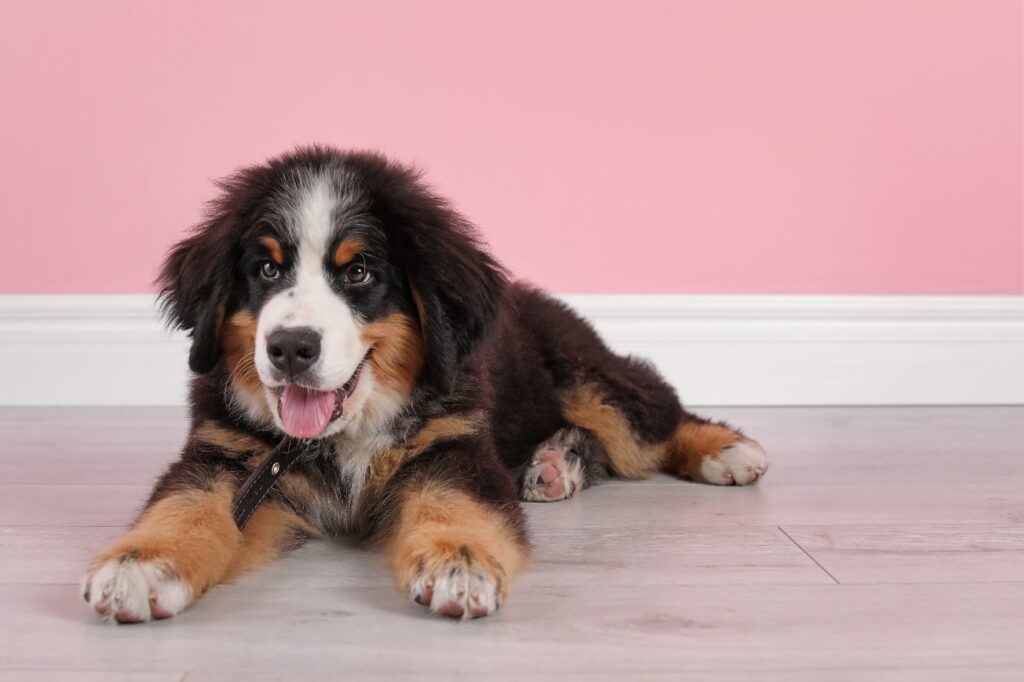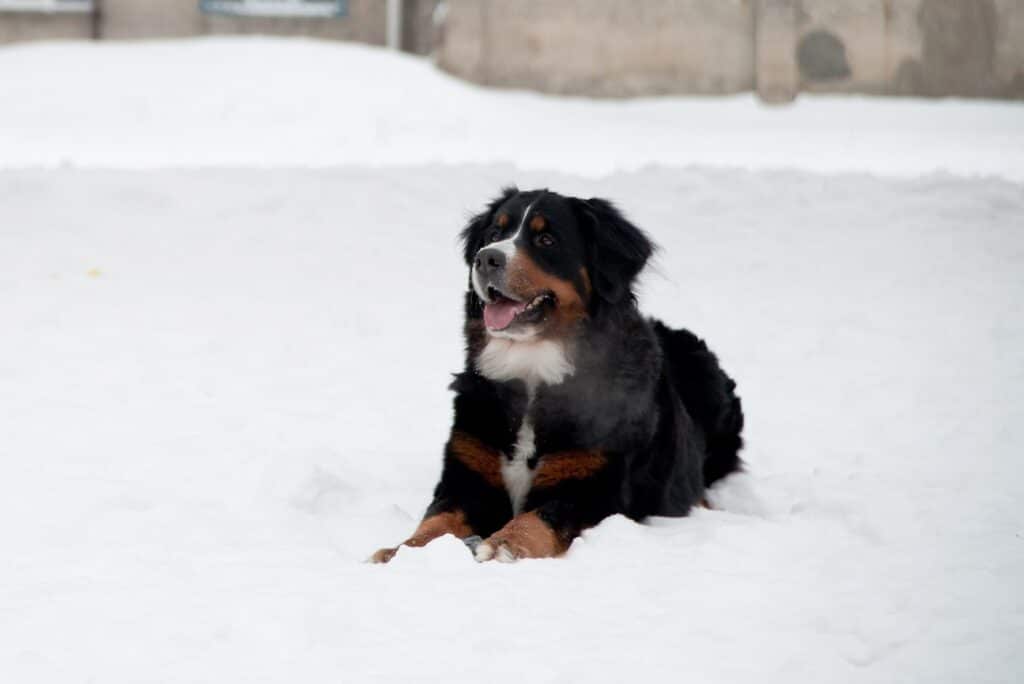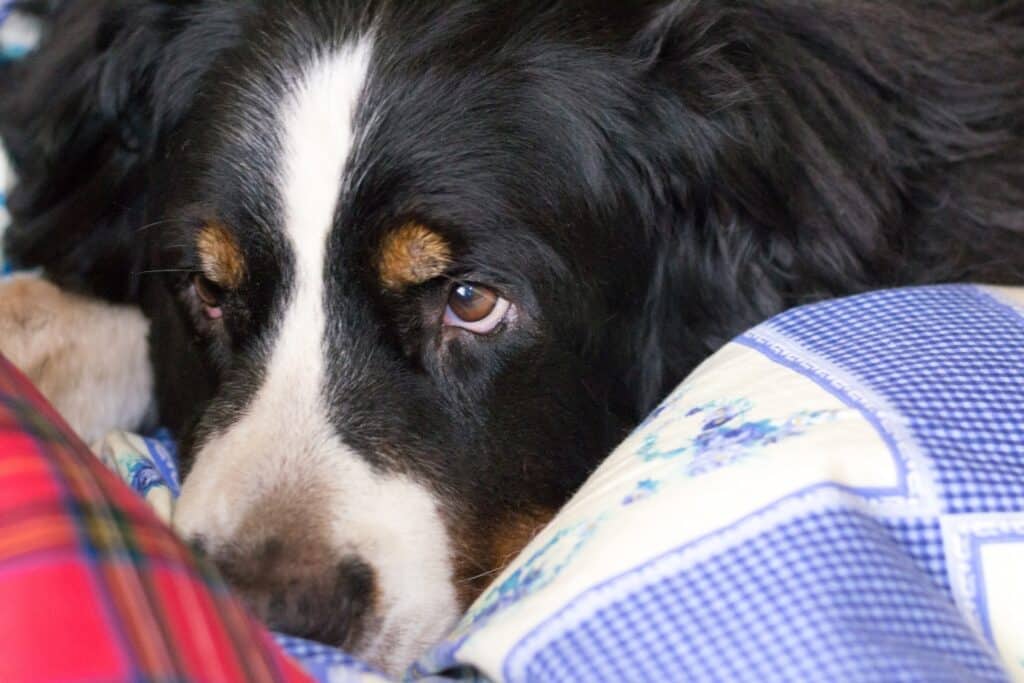Shaving a Bernese Mountain dog may seem like a good idea to keep them cool during hot weather, but it can actually cause health problems.
In this blog post, we will explore the potential issues associated with shaving a Bernese Mountain dog and provide alternative ways to keep them comfortable in warmer temperatures.
Is it Possible for Bernese Mountain Dogs to be Shaved?
Yes, however, no reputable groomer or dog owner would shave a Bernese Mountain Dog. The coat is one of the most distinguishing features of the breed. It is thick, long, and silky, and it helps to protect the dog from both the cold and the heat.
In addition, shaving a Bernese Mountain Dog can actually be dangerous. The coat helps to insulate the skin, and when it is removed, the skin is vulnerable to sunburn, insect bites, and other irritations.
Shaving can irritate your dog’s skin and cause rashes or other problems. Additionally, if the hair is not cut properly, it can grow back in unevenly and cause your dog discomfort. For these reasons, it is best to leave Bernese Mountain Dogs in their natural state.
If you eventually decide to shave this breed, it is advisable to consult with a professional groomer before doing so.
Does the Bernese Mountain Dog benefit from being Shaved?

While it is not advisable to shave your dog, many people think shaving a dog in the summer helps them cool off. There are other perceived benefits to shaving a Bernese Mountain Dog, especially those with longer coats.
Shaving can help to prevent mats and tangles, which can be painful for the dog and difficult to brush out. In addition, it can help to reduce shedding by removing dead hair from the coat.
Finally, shaving can also make it easier to spot any skin issues, such as rashes or hot spots. However, it is important to use caution when shaving this breed, as their skin is quite sensitive.
“Be sure to use a sharp blade and avoid going too deep, as this could cause irritation or even cuts. If you are not comfortable shaving your dog yourself, it is best to leave it to the professionals”.
With proper care, shaving can be a great way to keep your Bernese Mountain Dog healthy and happy year-round.
Problems With Shaving a Bernese Mountain Dog
Although there are some benefits to shaving a Bernese Mountain Dog, there are also several problems that can occur.
Increases Their Exposure to The Sun
One of the main problems with shaving a Bernese Mountain Dog is that it increases its exposure to the sun. The coat helps to protect their skin from harmful UV rays, and without it, they are more susceptible to sunburn.
Increases Exposure to Insects And Bugs
Another problem with shaving a Bernese Mountain Dog is that it increases its exposure to insects and bugs. The coat helps to keep insects away from their skin, and without it, they are more likely to be bitten by mosquitoes or other pests.
Reduces Protection From Cold Weather
Shaving a Bernese Mountain Dog also reduces their protection from cold weather. The coat helps to insulate their body and keep them warm in colder climates, and without it, they are more likely to suffer from hypothermia.
Furthermore, shaving this breed causes skin irritation more often than not. The dog’s skin is very sensitive, and without the coat to protect it, the skin is more susceptible to rashes and other skin infections.
Will a Berner’s hair regrow after shaving?

Yes, the hair will grow back after shaving, but it may not be as thick or full as it was before. Additionally, the new hair may be a different color or texture than the original coat.
The Bernese Mountain Dog’s coat is made up of two types of hair: the outer coat, which is coarse and waterproof, and the undercoat, which is soft and dense. Both types of hair play an important role in protecting the dog from the cold.
However, the undercoat also sheds heavily twice a year, making it a nuisance for many owners. As a result, some people choose to shave their dog’s coat in order to reduce shedding.
“While shaving will help to reduce shedding in the short term, it can also damage the coat and cause long-term problems. The Bernese Mountain Dog’s coat is designed to protect the dog from the cold, and shaving removes this important layer of protection”.
In addition, shaving can stimulate the growth of the undercoat, leading to even more shedding in the future. As a result, it is generally not recommended to shave a Bernese Mountain Dog’s coat.
Will a Bernese Mountain Dog Remain Cool after being Shaved?
It’s a common misconception that shaving a Bernese Mountain Dog will help them stay cool in the summer heat. In fact, shaving a Bern’s double coat can actually do more harm than good.
The topcoat provides insulation against both hot and cold weather, and the undercoat helps to regulate body temperature. shaving removes this natural protection and can leave the dog vulnerable to sunburn, heat stroke, and other health problems.
In addition, the coat helps to repel dirt and bugs, so shaving also increases the chances of your dog picking up infections. For all these reasons, it’s best to leave your Bernese Mountain Dog’s coat intact during summer.
If you’re concerned about them getting too hot, provide them with plenty of shade and water, and make sure to take them for shorter walks during the hottest hours of the day. With a little care, your Bernese will stay happy and healthy all summer long.
Will Shaving a Bernese Mountain Dog Affect their Coat?

Though it may seem like a good idea to shave a Bernese mountain dog in the heat of the summer, doing so can actually have a negative effect on their coat. The thick, double coat of this breed is designed to protect them from both hot and cold weather.
Shaving the coat will leave them vulnerable to sunburn and overheating. In addition, the shaving process can damage the hair follicles, leading to a dull and patchy coat.
For these reasons, it’s best to avoid shaving a Bernese mountain dog altogether. If you must trim their fur, be sure only to use scissors or a clipper with a guard, and avoid going too short.
This will help to ensure that your dog’s coat remains healthy and lustrous for years to come.
How to Trim a Berner’s Coat?
Bernese Mountain Dogs have a thick, long coat that needs to be brushed regularly to prevent mats and tangles. The best way to keep the coat healthy and looking its best is to trim it every few months. Here are some tips on how to trim their coat:
Start with Combing their Hair:
Before you start trimming, it’s important to comb out the dog’s hair to remove any knots or tangles. This will make trimming much easier and help to prevent accidental cuts. It is also important to use the right kind of comb.
A wide-toothed comb is best for Bernese Mountain Dogs, as their coats can be very dense. Comb gently to avoid hurting the dog, and be sure to work through any knots slowly.
Some people like to make the hair wet before combing, as this can help to reduce static and make the process easier.
Apply a Shedding Blade:
Once the dog’s coat is free of knots, you can start trimming. A shedding blade is a special comb that is designed to remove loose hair. Begin at the back of the neck and work your way down the body, using long, even strokes.
Be careful not to press too hard, as this can damage the coat. You may need to go over the same area multiple times to remove all the loose hair.
Use Scissors for the Face and Feet:
It’s best to use scissors when trimming around the face and feet, as this will help to avoid accidentally cutting the dog. Start with the hair on the top of the head, working your way down to the eyebrows.
Then, trim the hair around the ears, being careful not to cut the ear itself. Next, trim any long hair on the feet, taking care not to cut the toenails. Finally, you can trim the whiskers if desired.
Finish up with a Brush:
Once you’ve finished trimming, it’s important to brush the dog’s coat to remove any remaining loose hair.
This will help to keep the coat looking neat and tidy. It’s also a good idea to give the dog a bath after trimming, as this will help to remove any stray hairs that were missed during the trimming process.
Utilize Electric Clippers:
If you find that trimming the coat with scissors is too difficult, you can always use electric clippers. Begin by attaching a guard to the clippers, then start at the back of the neck and work your way down the body.
Be sure to go slowly and avoid pressing too hard, as this can damage the coat. You may need to go over the same area multiple times to get all the loose hair.
Once you’ve finished trimming, remove the guard and use the clippers to neaten up the edges. Finish up by brushing the dog’s coat to remove any remaining loose hair.
Start with a Small Area:
When trimming the dog’s fur, it’s best to start with a small area and work your way up. This will help you get a feel for the coat and how much you need to trim. Be careful not to cut too much, as you can always trim more if necessary.
Be Extra Careful Around Sensitive Areas: There are some areas that you need to be extra careful about when trimming, such as the face, feet, and genitals.
These areas are much more sensitive than the rest of the body, so it’s important to take extra care when trimming them. Be sure to use scissors when trimming around the face and feet, and avoid trimming too close to the genitals.
Get Professional Help:
If you’re not confident in your ability to trim the dog’s fur, you can always seek professional help.
There are many groomers who offer coat-trimming services, so you can find one in your area that can do the job for you. This is usually the best option if you’re not sure how to trim the fur correctly.
Trim any excess Hair
After you’ve finished trimming the coat, you can trim any excess hair that’s left behind. This includes any stray hairs that were missed during the trimming process, as well as any long hairs that are sticking out.
Be sure to use sharp scissors and take care not to cut too much. Once you’re finished, brush the dog’s coat to remove any remaining loose hair.
“Shaving a Bernese Mountain Dog is not recommended, as it can damage their coat. If you must trim their fur, be sure only to use scissors or a clipper with a guard, and avoid going too short. With a little care, your Bernese will stay happy and healthy all summer long”.
Final Thoughts
If you are considering shaving your Bernese Mountain Dog, think about the potential problems that could arise from doing so. Infection, skin irritation, and a decrease in insulation are all possible health concerns for a shaved dog.
You can also try some of the tips that we have mentioned. As you can see, it’s relatively easy to trim a Bernese Mountain Dog’s coat. By following these simple steps, you can help to keep your dog’s coat looking its best all year long.
But if you’re not sure you can do it safely, be sure to consult with a professional groomer or vet to ensure that it is done safely and properly.


